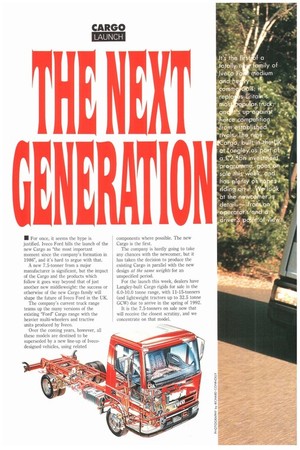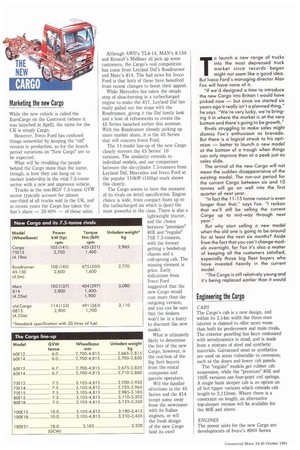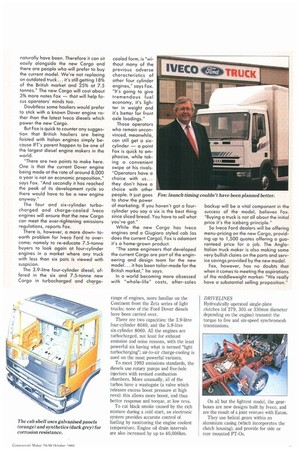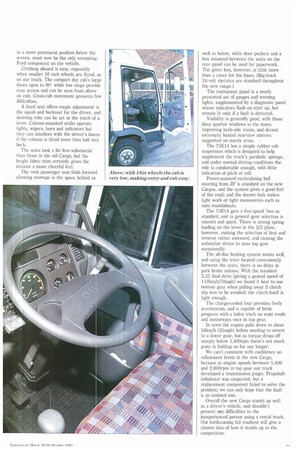• For once, it seems the hype is justified. Iveco
Page 48

Page 50

Page 51

Page 52

Page 53

If you've noticed an error in this article please click here to report it so we can fix it.
Ford bills the launch of the new Cargo as "the most important moment since the company's formation in 1986", and it's hard to argue with that.
A new 7.5-tonner from a major manufacturer is significant, but the impact of the Cargo and the products which follow it goes way beyond that of just another new middleweight: the success or otherwise of the new Cargo family will shape the future of Iveco Ford in the UK.
The company's current truck range teams up the many versions of the existing "Ford" Cargo range with the heavier multi-wheelers and tractive units produced by Iveco.
Over the coming years, however, all these models are destined to be superseded by a new line-up of Ivecodesigned vehicles, using related components where possible. The new Cargo is the first.
The company is hardly going to take any chances with the newcomer, but it has taken the decision to produce the existing Cargo in parallel with the new design at the same weights for an unspecified period.
For the launch this week, dealers have Langley-built Cargo rigids for sale in the 6.0-10.0 tonne range, with 11-15-tonners (and lightweight tractors up to 32.5 tonne GCW) due to arrive in the spring of 1992.
It is the 7.5-tonners on sale now that will receive the closest scrutiny, and we concentrate on that model.
It's the firs f a totally n family of Iveco Fo medium and he yl" COMM Cie§ ; it repla s Britaic's rTIOS •()pular truck; an t's up-a?ain'st fierce competition from established 'rivals. The new argo, built in the-OK • at Langley as part of 40 a £2.5bn investment programme, goes on sale this we'k, and has plenty of hopes riding on it. li'Vrilook at the newcomer irl_ detail — frorman 111 operator's and a 4k, driver's p4lig of Vie'vv: Marketing the new Cargo While the new vehicle is called the EuroCargo on the Continent (where it was launched in April), the name for the UK is simply Cargo.
However, Iveco Ford has confused things somewhat by keeping the "old" version in production, so for the launch period variations on "New Cargo" are to be expected.
What will be troubling the people behind the Cargo more than the name, though, is how they can hang on to market leadership in the vital 7.5-tonne sector with a new and unproven vehicle.
Trucks in the non-HGV 7.5-tonne GVW sector typically account for almost one-third of all trucks sold in the UK, and in recent years the Cargo has taken the lion's share — 35-40% — of these sales. Although AWD's TL8-14, MAN's 8.150 and Renault's Midliner all pick up some customers, the Cargo's real competition has come from Leyland Daf's Roadrunner and Merc's 814. The bad news for Iveco Ford is that both of these have benefited from recent changes to boost their appeal.
While Mercedes has taken the simple step of shoe-horning in a turbocharged engine to make the 817, Leyland Daf has really pulled out the stops with the Roadrunner, giving it the Daf family look and a host of refinements to create the 45 Series launched earlier this summer. With the Roadrunner already picking up more market share, it is the 45 Series that will concern Iveco Ford.
The 11-model line-up of the new Cargo closely mirrors the 45 Series' 10 versions. The similarity extends to individual models, and our comparison between the six-cylinder 7.5-tonners from Leyland Daf, Mercedes and Iveco Ford at the popular 110kW (150hp) mark shows this clearly.
The Cargo seems to have the measure of its rivals on detail specification. Engine choice is wide, from compact fours up to the turbocharged six which is (just) the most powerful in the class. There is also a lightweight tractor, and the choice between "premium" 80E and "regular" 75E 7.5-tonners, with the former getting a beefed-up chassis and a coil-sprung cab. The missing element is price. Early indications from Iveco Ford suggested that the new Cargo would cost more than the outgoing version, and you can be sure that the dealers won't be in a hurry to discount the new model.
2,770 3,080 3,110 Unladen weight' kg 2,965
What is ultimately likely to determine the fate of the new Cargo, however, is the reaction of the big fleet buyers from the rental companies and parcels operators.
Will the familiar drivelines in the 45 Series and the 814 tempt some away from the newcomer with its Italian engines, or will the fresh design of the new Cargo hold its own? T. launch a new range of trucks into the most depressed truck market since records began might not seem like a good idea. But Iveco Ford's managing director Alan Fox will have none of it.
"If we'd designed a time to introduce the new Cargo into Britain I would have picked now — but since we started six years ago it really isn't a planned thing," he says. "We're very lucky, we're bringing it in where the market is at the very bottom and there's going to be growth."
Rivals struggling to make sales might dismiss Fox's enthusiasm as bravado. But there is a logical streak to his optimism — better to launch a new model at the bottom of a trough when things can only improve than at a peak just as sales slide.
The arrival of the new Cargo will not mean the sudden disappearance of the existing model. The run-out period for the current Cargo between six and 10 tonnes will go on well into the first quarter of next year.
"In fact the 11-15 tonne runout is even longer than that," says Fox. "I reckon that we'll still be selling the current Cargo up to mid-way through next year."
But why start selling a new model when the old one is going to be around for at least the next six months? Aside from the fact that you can't change models overnight, for Fox it's also a matter of keeping all the customers satisfied, especially those big fleet buyers who have invested heavily in the current model.
"The Cargo is still relatively young and it's being replaced earlier than it would
Engineering the Cargo
CABS The Cargo's cab is a new design, and within its 2.14m width the three-man interior is claimed to offer more room than both its predecessor and main rivals. The exterior panelling has been contoured with aerodynamics in mind, and is made from a mixture of steel and synthetic materials. Galvanised steel or synthetics are used on areas vulnerable to corrosion, such as the doors and lower cab panels.
The "regular" models get rubber cab suspension, while the "premium" 80E and 100E versions use four-point coil springs. A single bunk sleeper cab is an option on all but tipper variants which extends cab length to 2,115mm. Where there is a constraint on length, an alternative top-sleeper version will be available for the 80E and above.
ENGINES The power units for the new Cargo are developments of Iveco's 8000 Series
naturally have been. Therefore it can sit easily alongside the new Cargo and there are people who will prefer to buy the current model. We're not replacing an outdated truck ... it's still getting 18% of the British market and 25% at 7.5 tonnes." The new Cargo will cost about 3% more notes Fox — that will help focus operators minds too.
Doubtless some hauliers would prefer to stick with a known Dover engine rather than the latest Iveco diesels which power the new Cargo.
But Fox is quick to counter any suggestion that British hauliers are being foisted with Italian engines simply because IFT's parent happen to be one of the largest diesel engine makers in the world.
"There are two points to make here. One is that the current Dover engine being made at the rate of around 8,000 a year is not an economic proposition," says Fox. "And secondly it has reached the peak of its development cycle so there would have to be a new engine anyway."
The four and six-cylinder turbocharged and charge-cooled !veto engines will ensure that the new Cargo can meet the ever-tightening emissions regulations, reports Fox.
There is, however, a more downtoearth problem for Iveco Ford to overcome; namely to re-educate 7.5-tonne buyers to look again at four-cylinder engines in a market where any truck with less than six pots is viewed with suspicion.
The 3.9-litre four-cylinder diesel, offered in the six and 7.5-tonne new Cargo in turbocharged and charge
cooled form, is "without many of the previous adverse characteristics of other four cylinder engines," says Fox. "It's going to give tremendous fuel economy, it's lighter in weight and it's better for front axle loadings."
Those operators who remain unconvinced, meanwhile, can still get a sixcylinder — a point Fox is quick to emphasise, while taking a convenient swipe at his rivals: "Operators have a choice with us... they don't have a choice with other people. It just goes to show the power of marketing. If you haven't got a fourcylinder you say a six is the best thing since sliced bread. You have to sell what you've got."
While the new Cargo has Iveco engines and a Giugiaro styled cab (as does the current Cargo), Fox is adamant it's a home-grown product.
"The same engineers that developed the current Cargo are part of the engineering and design team for the new model ... it has been tailor-made for the British market," he says.
In a world becoming more obsessed with "whole-life" costs, after-sales backup will be a vital component in the success of the model, believes Fox. "Buying a truck is not all about the initial price it's the iceberg principle."
So Iveco Ford dealers will be offering menu-pricing on the new Cargo, providing up to 1,500 quotes offering a guaranteed price for a job. The AngloItalian truck maker is also making some very bullish claims on the parts and service savings provided by the new model.
Fox, however, has no doubts that when it comes to meeting the aspirations of the middleweight market: "We really have a substantial selling proposition."
range of engines, more familiar on the Continent from the Zeta series of light trucks; none of the Ford Dover diesels have been carried over.
There are two capacities; the 3.9-litre four-cylinder 8040, and the 5.9-litre six-cylinder 8060. All the engines are turbocharged, not least for exhaust emission and noise reasons, with the least powerful six having what is termed "light turbocharging"; air-to-air charge-cooling is used on the most powerful variants.
To meet 1993 emissions standards, the diesels use rotary pumps and five-hole injectors with revised combustion chambers, More unusually, all of the turbos have a wastegate (a valve which releases excess boost pressure at high revs): this allows more boost, and thus better response and torque, at low revs.
To cut black smoke caused by the rich mixture during a cold start, an electronic system provides accurate control of fuelling by monitoring the engine coolant temperature. Engine oil drain intervals are also increased by up to 40,000km. DRIVELINES Hydraulically operated single-plate clutches (of 279, 305 or 330mm diameter depending on the engine) transmit the torque to five and six-speed synchromesh tranmissions..
On all but the lightest model, the gearboxes are new designs built by Iveco, and are the result of a joint venture with Eaton.
They use helical gears within an aluminium casing (which incorporates the clutch housing), and provide for side or rear mounted PT-Os. The drive axles are all the single-reduction hypoid type, with new Iveco designs on the lighter models and Rockwell units above 7.5 tonnes. As many as six final-drive ratio options can be specified.
CHASSIS AND RUNNING GEAR Flat-topped steel chassis frames are used, with deeper webs on the 80E and 100E Cargos; five wheelbase options are provided for the 7.5-tonners, and body lengths of up to 7.2m can be accommodated. The front axles are again new Iveco designs, and like the rear axles, they use oil-filled hubs. The choice of 16 or 17.5 inch wheels is offered on the 75E, with the smaller diameter bringing a platform height reduction of 27mm; low profile 75% aspect tyres can be fitted throughout the range.
Taking a lead from the old Cargo, all 6-10 tonne vehicles get disc brakes all round, with air-over-hydraulic actuation. Wabco or Bosch ABS (and ASR traction control) is a planned option for all models during 1992.
The standard suspension uses parabolic springs front and rear, but conventional multi-leaf springs are an option, and are standard on tipper chassis.
Four-bag rear air suspension is soon to be available on 6-10 tonne Cargos, and for those interested in demountable operation, front axle air suspension on models down to the 80E is promised in the near future.
Driving the Cargo
Commercial Motor took out Job 12 from the new production line at Langley for a day's driving. This was a 75E14 S, a model which Iveco Ford hopes will become one of the big sellers.
It is the 7.5-tonner built for solo operation, equipped with the charge-cooled four-cylinder engine rated at 100kW (134hp). With the four being 245kg lighter than the slightly more powerful six in the 75E15, it should be an attractive option for those seeking a productive non-HGV vehicle.
Our test truck gives a body/payload allowance of 4,695kg with its 4.185m wheelbase.
Approaching the Italian job for the first time, the cab looks fresh and modern, helped by the aerodynamically radiused corners. The shape of the door windows gives a hint of the old Cargo, but this is an illusion: the blue oval badge, reinstated in a more prominent position below the screen, must now be the only remaining Ford component on the vehicle.
Climbing aboard is easy, especially when smaller 16 inch wheels are fitted, as on our truck. The compact day cab's large doors open to 90' while low steps provide easy access and can be seen from above on exit. Cross-cab movement presents few difficulties.
A fixed seat offers ample adjustment in the squab and backrest for the driver, and steering rake can be set at the touch of a lever. Column-mounted stalks operate lights, wipers, horn and indicators but they can interfere with the driver's knees if the column is tilted more than half way back.
The seats look a bit less substantial than those in the old Cargo, but the bright fabric trim certainly gives the interior a more cheerful feel.
The twin passenger seat folds forward allowing stowage in the space behind as well as below, while door pockets and a box mounted between the seats on the rear panel can be used for paperwork. The glove box, however, is little more than a cover for the fuses. (Big-truck 24-volt electrics are standard throughout the new range.) The instrument panel is a neatly presented set of gauges and warning lights, supplemented by a diagnostic panel whose indicators flash on start up, but remain lit only if a fault is detected.
Visibility is generally good, with those deep quarter windows in the doors improving kerb-side vision, and decent externally heated rearview mirrors supported on sturdy arms. • The 75E14 has a simple rubber cab suspension which is designed to help supplement the truck's parabolic springs, and under normal driving conditions the ride is comfortable enough, with little indication of pitch or roll.
Power-assisted recirculating ball steering from ZF is standard on the new Cargos, and the system gives a good feel of the road; and the decent lock makes light work of tight manoeuvres such as mini roundabouts.
The 75E14 gets a five-speed 'box as standard, and in general gear selection is smooth and quick. There is strong spring loading on the lever in the 2/3 plane, however, making the selection of first and reverse rather awkward, and causing the unfamiliar driver to miss top gear occasionally.
The all-disc braking system works well, and using the lever located conveniently between the seats, there is no delay in park brake release. With the standard 3.31 final drive (giving a geared speed of 1I2km/h/70mph) we found it best to use bottom gear when pulling away if clutch slip was to be avoided; the clutch itself is light enough.
The charge-cooled four provides lively acceleration, and is capable of brisk progress with a laden truck on main roads and motorways once in top gear.
In town the engine pulls down to about 56km/h (35mph) before needing to revert to a lower gear, but as torque drops off steeply. below 1,400rpm there's not much point in holding on for any longer.
We can't comment with confidence on refinement levels in the new Cargo, because at engine speeds between 1,400 and 2,000rpm in top gear our truck developed a transmission jangle. Propshaft imbalance was suspected, but a replacement component failed to solve the problem; we can only hope that the fault is an isolated one.
Overall the new Cargo stands up well as a driver's vehicle, and shouldn't present ally difficulties to the inexperienced person using a rental truck. Our forthcoming full roadtest will give a clearer idea of how it stands up to the competition.




























































































